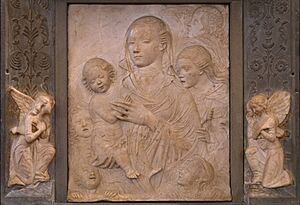Agostino di Duccio facts for kids

Agostino di Duccio (born in 1418, died around 1481) was an important Italian sculptor during the early Renaissance period. He created many beautiful works of art, especially sculptures, that are still admired today.
Contents
Early Life and Learning
Agostino was born in Florence, a famous city in Italy known for its art. He learned his skills by working with two very famous sculptors, Donatello and Michelozzo, in a town called Prato. They taught him a lot and greatly influenced his artistic style.
In 1441, Agostino faced a problem and had to leave Florence. The next year, he continued working on an altar for the Cathedral of Modena. You can see the influence of Michelozzo in this work.
Studying in Venice
In 1446, Agostino traveled to Venice, another Italian city famous for its art. There, he studied Gothic sculpture, which was an older style of art. He also met another sculptor named Matteo de' Pasti.
Working on the Tempio Malatestiano
Matteo de' Pasti asked Agostino to help decorate a special building called the Tempio Malatestiano in Rimini. Agostino worked there from 1449 to 1457.
What Kind of Art Was It?
The decorations at the Tempio Malatestiano were like a big art encyclopedia. They included carvings of zodiac signs, which are symbols related to the stars, and other figures from stories and myths. It was a very detailed and interesting project.
Sculptures in Perugia and Florence
Between 1457 and 1462, Agostino created the stunning marble front of the church of S. Bernardino in Perugia. This is one of his most famous works.
After that, until 1470, he made many sculptures, especially in Florence. One of these was a sculpture called Madonna d'Auvillers, which he made for a powerful family, the Medici. This sculpture is now in the Louvre museum in Paris.
The Giant Marble Block for David
In 1464, the people in charge of the Duomo cathedral in Florence asked Agostino to carve a huge marble statue of David. David was a hero from the Old Testament and a symbol of Florence. The statue was planned to be about 3.5 meters (over 11 feet) tall.
Getting the Marble
Agostino traveled to Carrara, a place famous for its marble, to get a very large block. This block was huge, over 5 meters (16 feet) long, and weighed more than 20 tons! It was a big challenge to move it to Florence.
A Project Not Finished
Agostino started working on the block, shaping it roughly. But in December 1466, he stopped working on the project. The huge marble block, which people called il gigante (the giant), sat in the Duomo yard for 24 years. Later, in 1504, another very famous artist named Michelangelo used this same block to carve his incredible David statue.
Other Works and Later Life
In 1473, Agostino designed the outside of the Porta di San Pietro, a gate in the city walls of Perugia. His style for this gate was influenced by another famous artist, Leone Battista Alberti.
You can also see his works in Amelia and at the National Gallery of Umbria in Perugia. Agostino di Duccio passed away around 1481 in Perugia.
See also
 In Spanish: Agostino di Duccio para niños
In Spanish: Agostino di Duccio para niños


